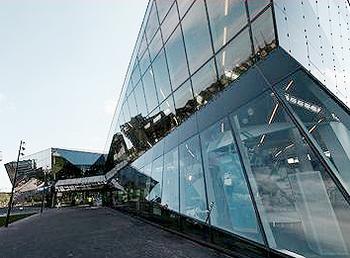
LONDON, UK, September 20, 2012 (ENS) – The world’s largest exhibit spotlighting sustainable urban development is at the core of London’s shiny new technology and innovation center, the Crystal, created by the German corporation Siemens AG.
“Cities are the engines of the world economy and also have the greatest impact on the environment,” said Siemens President and CEO Peter Löscher at the opening ceremony on Wednesday. “The development of our planet will stand or fall with the development of cities.”

The crystal-shaped glass structure will open to the public on September 29 when visitors will get their first look at cities envisioned as they might be in the year 2050. “Looking ahead to the urban future,” said Löscher, “the Crystal showcases a wide variety of opportunities and concrete solutions.”
Located in the Borough of Newham, at the historic Royal Victoria Docks, the Crystal is part of the redevelopment of East London, a formerly run-down industrial area reconstructed for the 2012 Summer Olympic Games.
The Mayor of London Boris Johnson said, “The futuristic Crystal is a fantastic new landmark for London which has breathed new life into the historic Royal Docks. … It continues the rebirth of east London witnessed by the world this summer and I am determined to ensure this regeneration continues apace.”
The Crystal is the first and largest of three Centers of Competence Cities Siemens is building. The center in London offers Siemens experts and external professionals a platform for conducting research and exchanging ideas. Two smaller centers are planned for Shanghai and Washington in the coming years.
“Cities worldwide are making investments to improve their water supplies, power grids, transportation systems and building infrastructures. Our addressable market alone has a volume of €300 billion,” said Roland Busch, member of the Managing Board of Siemens AG and CEO of the company’s Infrastructure & Cities Sector.
With some 87,000 employees, the Sector provides sustainable technologies for urban areas and their infrastructures.
“The Crystal is our Sector’s showcase, contact point and mastermind,” said Busch, who believes the Crystal will help Siemens “intensify dialogue” with customers.
Today UN-Habitat held the inaugual conference at the Crystal, for 300 decision makers from cities around the world, including mayors, city planners, policy makers and thought leaders.
The UN agency launched a new guide, “Urban Planning for City Leaders,” detailing tools to support sustainable urban planning practices.
“All too often planning has been disconnected from the day to day realities and needs of citizens,” said UN-Habitat Executive Director Dr. Joan Clos. “This guide has been designed to fill the gap between the technical and the policy dimensions of urban planning and to help local leaders to better communicate with their planning departments and ask the right questions.”

More than half of the world’s population already lives in cities and over the next 20 years, that figure is expected rise to two-thirds of the population.
While relevant to cities of all sizes, the guide targets intermediate cities where the majority of urban growth is taking place – those with populations of between 20,000 and two million people in developing and emerging economies.
The new guide received financial support from Siemens and from the Swedish International Development Cooperation.
Busch said, “The ‘Urban Planning for City Leaders’ guide is a UN-Habitat initiative that Siemens is proud to support, because we believe that sustainable urban planning is one of the prerequisites for greening urban infrastructure.”
“Good urban planning can provide the framework for making decisions that are resource effective and sustainable for all cities,” he said.
On Friday, another conference will take place at the Crystal. Participants at the future-oriented Digital Life Design Cities conference, sponsored by Hubert Burda Media, will address questions relating to sustainable urban development and visions for smart cities.
Digital Life Design is a global conference network on innovation, digital media, science and culture that connects business, creative and social leaders, opinion leaders and investors.
“The city talks back,” says DLD sociologist Saskia Sassen. “We want to listen and enter this conversation, we want to learn and figure out how we can face the challenges and seize the possibilities. True to our nature, we take a close look at new technologies and how do they enable our cities, buildings, and objects to communicate with us.”
The €35 million Crystal was designed by award-winning Wilkinson Eyre Architects to be one of the world’s greenest buildings, with solar power, ground source heat pumps and energy-efficient LED lighting.
No fossil fuels are burned in the 6,300 square meter building. The Crystal consumes 50 percent less power and emits 65 percent less carbon dioxide than office buildings of comparable size. Rainwater is harvested for use or recycling, charging stations for electric vehicles are provided and the Crystal is designed for connection to London’s smart grid.
Siemens says that these innovations will secure a rating of Outstanding in the BREEAM assessment system and a LEED Platinum rating for the Crystal.
Copyright Environment News Service (ENS) 2012. All rights reserved.
© 2012, Environment News Service. All rights reserved. Content may be quoted only with proper attribution and a direct link to the original article. Full reproduction is prohibited.
